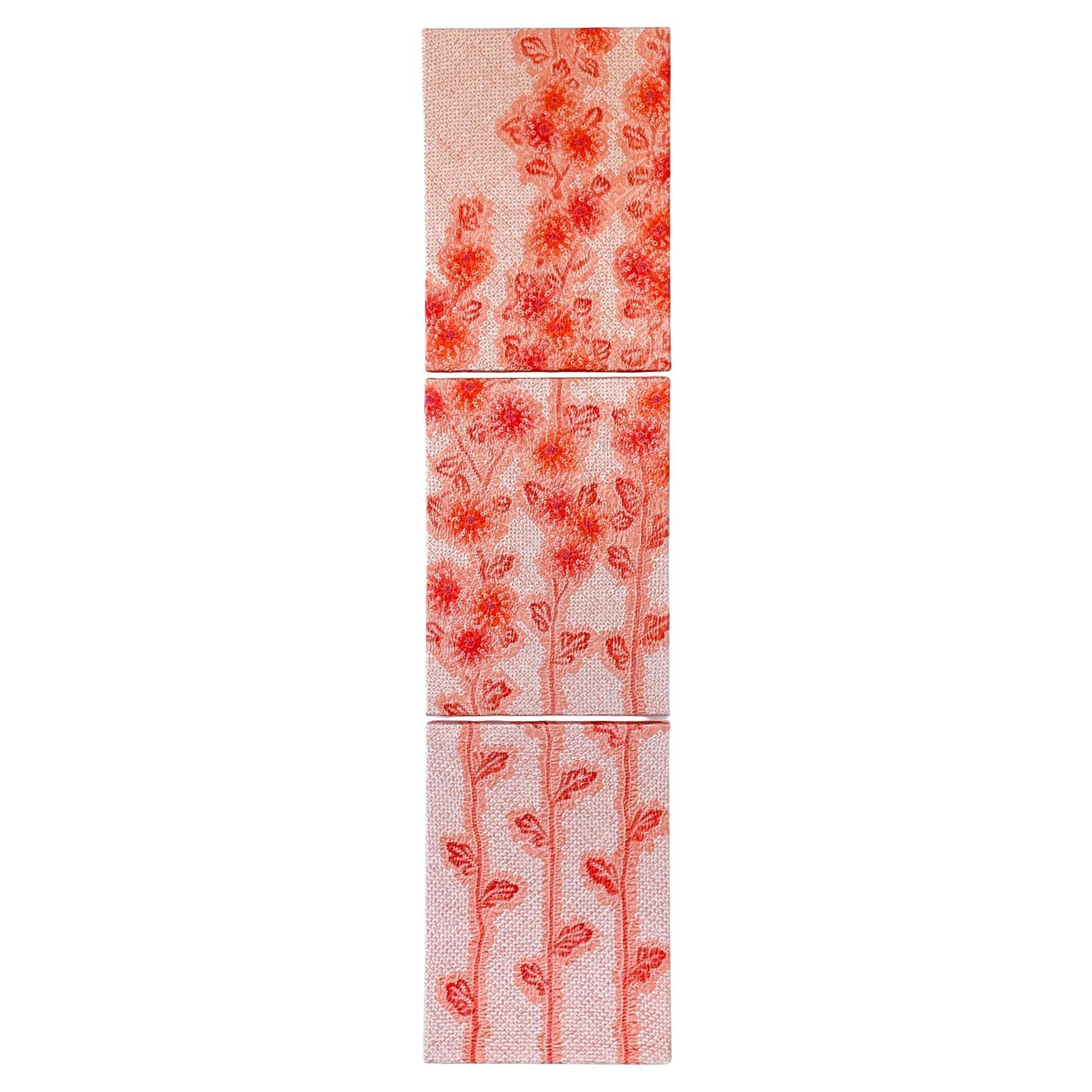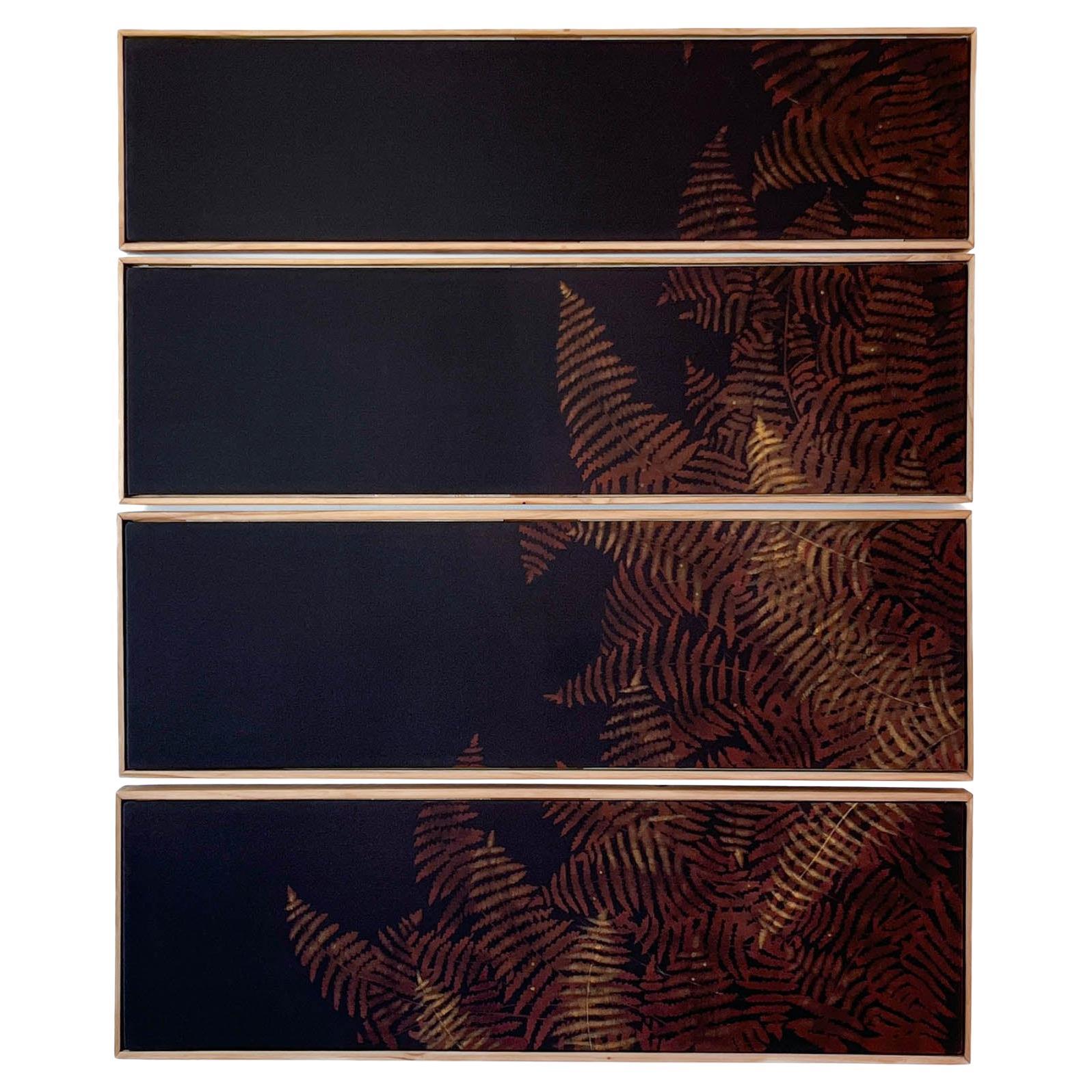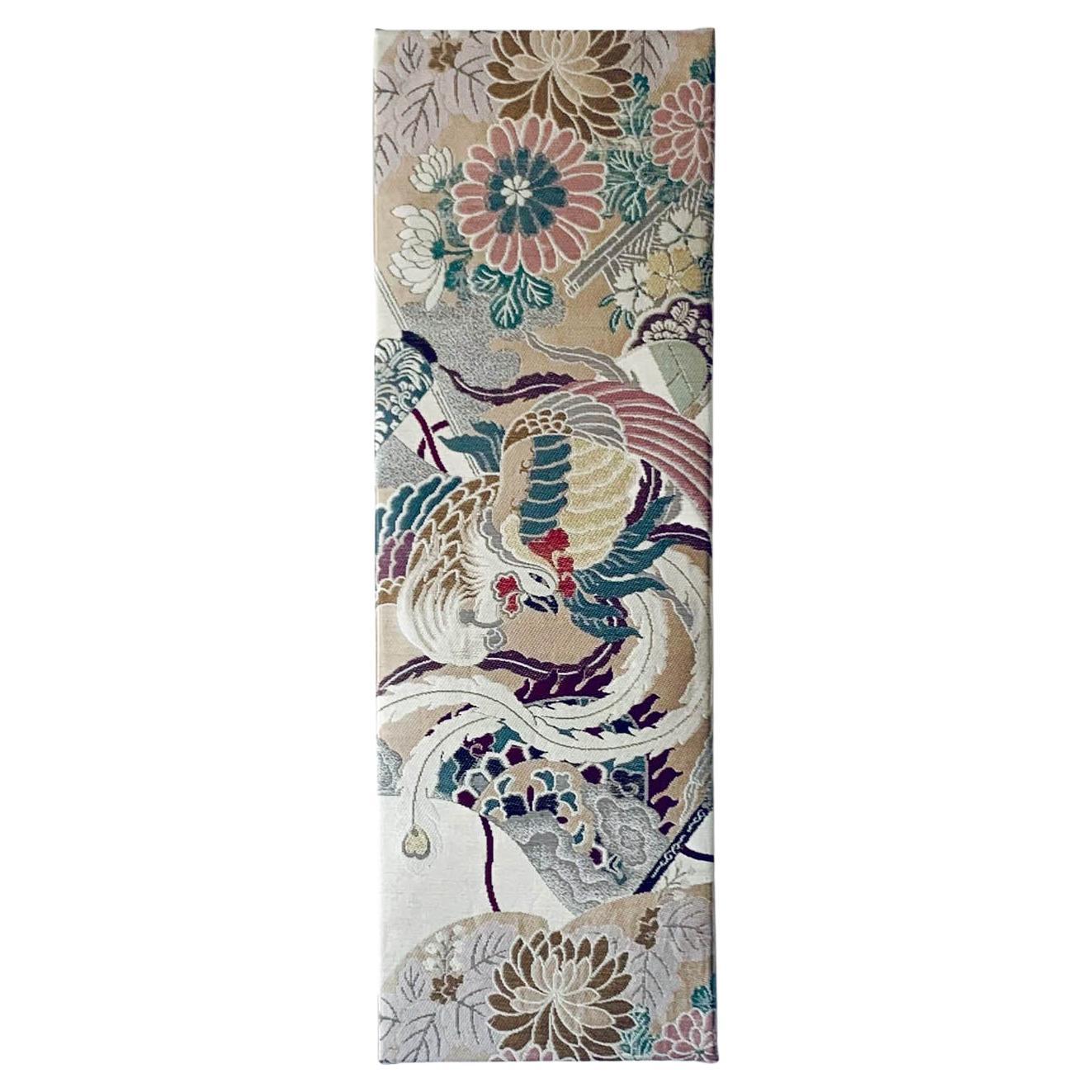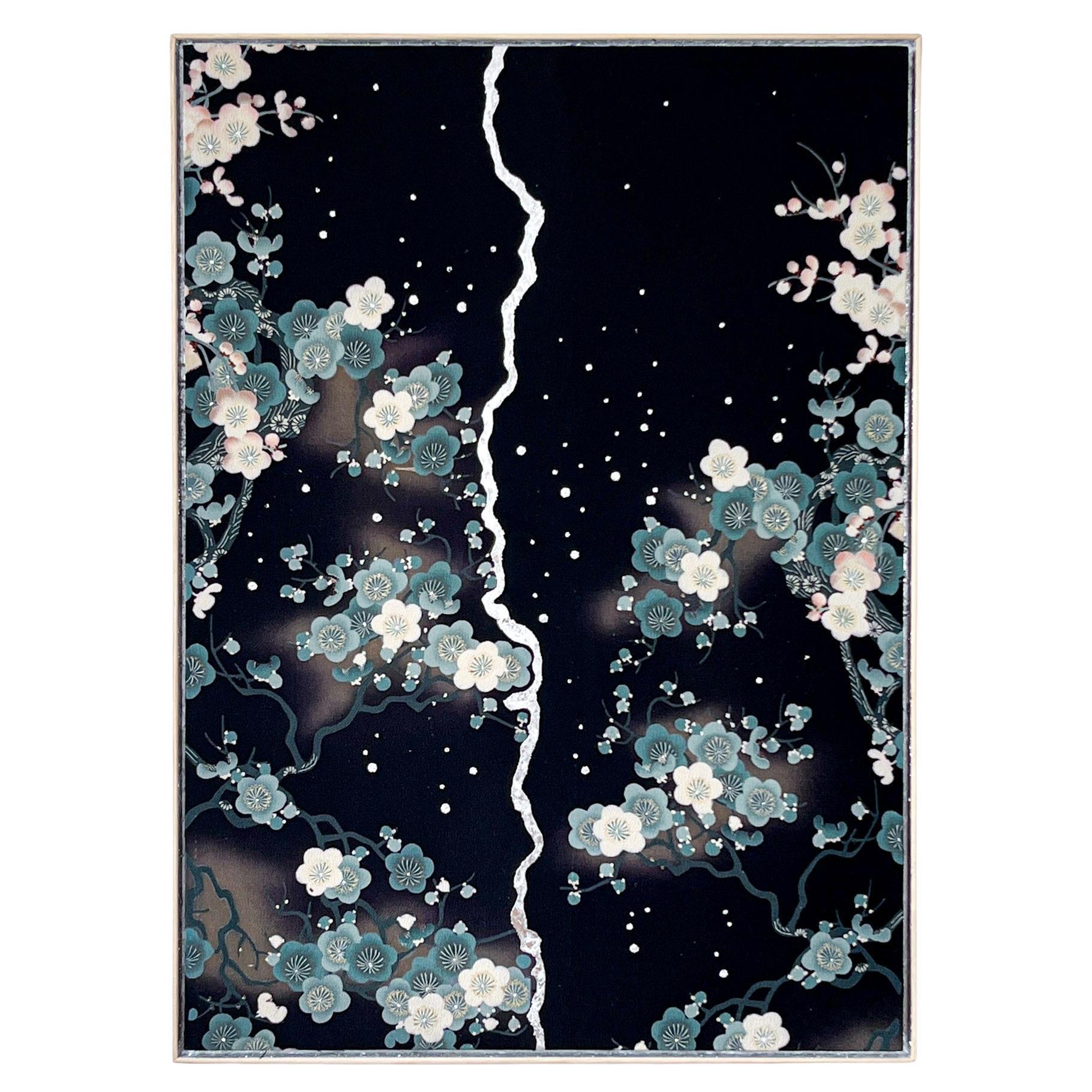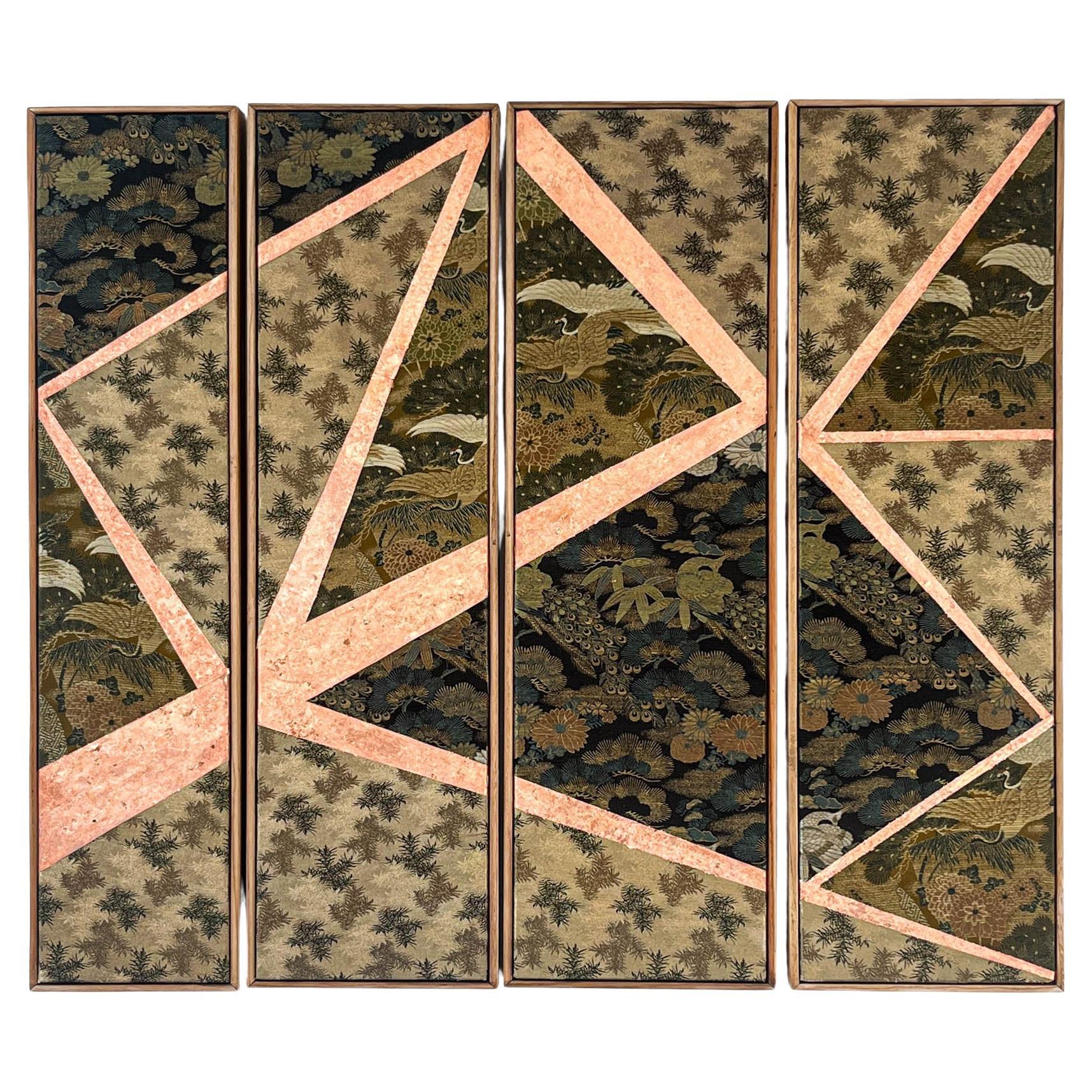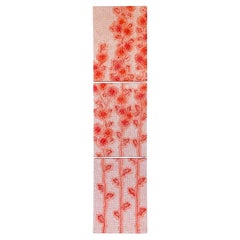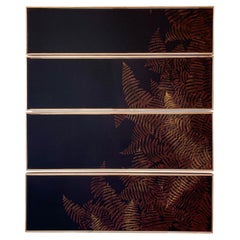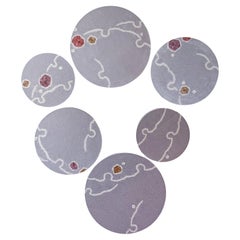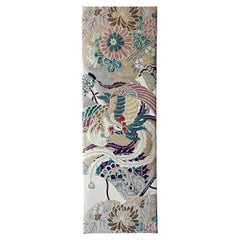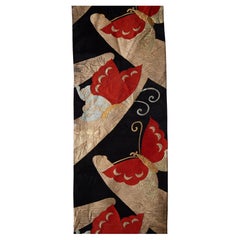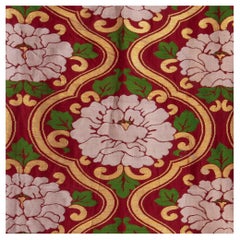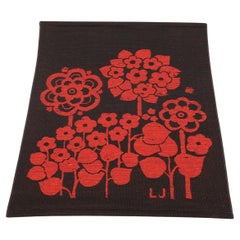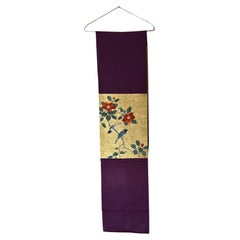Items Similar to Vintage kimono textile art "Flowers ~Life Circle~" by ikasu Pink, Black, Japan
Want more images or videos?
Request additional images or videos from the seller
1 of 21
Vintage kimono textile art "Flowers ~Life Circle~" by ikasu Pink, Black, Japan
$720
£549.72
€635.19
CA$1,010.74
A$1,126.58
CHF 591.08
MX$13,757.37
NOK 7,484.33
SEK 7,073.83
DKK 4,740.72
About the Item
<< About this canvas >>
This canvas is crafted from three different haori fabrics, each adorned with a shibori dyeing flower motif going through entire fabric. These fabrics tell a story of a flower from the budding stage on the left, through full bloom, and finally to the withering stage on the right.
<< Period / Story >>
The haori used in this canvas were made and used in the late Showa period (1960-80ies).
<< Explanation and meaning of pattern and colors >>
Canvases on both sides are dyed in black, while the middle canvas is colored in a gentle vermilion hue.
The vermilion color is a vibrant shade of red with a slight yellowish tint. In the past, the finest red pigment was referred to as "vermilion." Vermilion holds a symbolic connotation as the color of authority, and it is said that when ancient tombs are excavated, vermilion is often found alongside the remains of nobility.
Beyond its historical significance, vermilion carries multiple meanings, such as the warmth of fire, the radiant sun, protection against malevolent forces, warding off misfortune, fostering the prosperity of offspring, and promoting fertility.
<< Characteristics of the fabric >>
The fabrics in this canvases are all dyed using the tie-dyeing technique, known as "soshibori."
Soshibori has been practiced in Japan since the 6th to 7th century. In this technique, the cloth is meticulously bound using threads, boards, and other specialized tools to create areas where the dye cannot penetrate. After the entire cloth is dyed, the threads are carefully untied, leaving the tied areas untouched. This process results in a three-dimensional emergence of color, forming intricate patterns.
Due to the complicated nature of tie-dyeing, only a limited number of pieces, ranging from a few hundred to a few thousand, can be produced in a day. It is worth noting that the entire process can take several months to a year or even longer to complete, as more than 200,000 knots may be tied on a single kimono.
The "Kanoko shibori" applied to the entire haori fabric is a variety of so-called "fawn shibori", characterized by its resemblance to the spots on a young deer.
- Creator:Kimono ikasu (Artist)
- Dimensions:Height: 13.39 in (34 cm)Width: 31.5 in (80 cm)Depth: 0.79 in (2 cm)
- Style:Japonisme (In the Style Of)
- Materials and Techniques:
- Place of Origin:
- Period:
- Date of Manufacture:1970ies
- Condition:
- Seller Location:Setagaya City, JP
- Reference Number:1stDibs: LU10079243699122
About the Seller
No Reviews Yet
Vetted Professional Seller
Every seller passes strict standards for authenticity and reliability
1stDibs seller since 2024
- ShippingRetrieving quote...Shipping from: Setagaya City, Japan
- Return Policy
Authenticity Guarantee
In the unlikely event there’s an issue with an item’s authenticity, contact us within 1 year for a full refund. DetailsMoney-Back Guarantee
If your item is not as described, is damaged in transit, or does not arrive, contact us within 7 days for a full refund. Details24-Hour Cancellation
You have a 24-hour grace period in which to reconsider your purchase, with no questions asked.Vetted Professional Sellers
Our world-class sellers must adhere to strict standards for service and quality, maintaining the integrity of our listings.Price-Match Guarantee
If you find that a seller listed the same item for a lower price elsewhere, we’ll match it.Trusted Global Delivery
Our best-in-class carrier network provides specialized shipping options worldwide, including custom delivery.More From This Seller
View AllVintage kimono textile art " Growing ~ Longevity ~ " by ikasu Pink, Japan
By Kimono ikasu
Located in Setagaya City, JP
<< About this canvas >>
This set is a depiction of a tall chrysanthemum stem, entirely dyed in a traditional shibori technique.
<< Period / Story >>
The haori featured in this canvas was created and used during the late Showa period (1960-80ies).
<< Explanation and meaning of pattern and colors >>
A charming chrysanthemum flowers all around a stem seem to reach the heavens.
The chrysanthemum flower, which retains its vitality long after being cut, symbolizes longevity, purification from malevolent spirits, and good fortune. In ancient times, during the Kamakura period (1185-1333), emperors loved the chrysanthemum pattern, and it remains the most prestigious flower and the emblem of the Japanese imperial family...
Category
Vintage 1970s Japanese Japonisme Paintings and Screens
Materials
Canvas, Silk
Vintage kimono textile art "Fern ~Connection to Nature~" by ikasu Black , Japan
By Kimono ikasu
Located in Setagaya City, JP
This work uses an antique tomesode (festive kind of kimono) with fern design to evoke feelings of tranquility, harmony, and appreciation for the beauty of the environment. Can be used both vertically and horizontally.
It is elegantly framed with paulownia wood originally used for kimono chest-of-drawers, and is filled with storytelling and sense of luxury.
I used pieces of kimono that could no longer be used as clothing and kiritansu chest-of-drawers that would normally be discarded to create the ultimate upcycled piece.
<< Explanation of colors and patterns >>
In Japanese traditional culture, ferns, particularly the Japanese painted fern (Athyrium niponicum), hold several meanings and symbolisms:
・Elegance and Beauty: Ferns are admired for their graceful, delicate appearance and intricate leaf patterns. In Japanese aesthetics, they are appreciated for their natural beauty and are often used in gardens, landscapes, and floral arrangements to add a sense of refinement and elegance.
・Resilience and Perseverance: Ferns are known for their ability to thrive in diverse environments, including shady forests, rocky cliffs, and damp soil. Their resilience in the face of challenging conditions is seen as a symbol of endurance and perseverance. In Japanese culture, ferns may represent the ability to overcome adversity and flourish despite obstacles.
・Connection to Nature and Tranquility: Ferns are native to forested areas and are often associated with the natural world. In Japanese traditional culture, they symbolize a deep connection to nature and the importance of maintaining harmony with the environment. The lush green foliage of ferns evokes feelings of tranquility and peacefulness, making them popular motifs in Zen gardens and traditional landscape paintings.
・Purity and Simplicity: Ferns are emblematic of simplicity and purity in Japanese aesthetics. Their unassuming beauty and understated elegance reflect the principles of wabi-sabi, an aesthetic worldview that values imperfection, impermanence, and simplicity. Ferns may be used in tea ceremonies, Ikebana (flower arranging), and other traditional arts to evoke a sense of tranquility and appreciation for life's fleeting moments.
Overall, ferns in Japanese traditional culture symbolize elegance, resilience, connection to nature, purity, and simplicity. Their presence in art, literature, and landscape design underscores their enduring significance as symbols of natural beauty and spiritual resonance.
<< Characteristics of the fabric >>
This vintage textile is hand-painted with a traditional Japanese technique called "yuzen".
<< About the frame >>
Kiritansu - chest-of-drawers for kimono, is traditionally made from paulownia wood, a uniquely Japanese material closely tied to the world of kimonos.
Paulownia wood is known as the lightest wood in Japan, prased for its natural luster, resistance to moisture, and resilience against cracking. Since ancient times, it has been used in crafting furniture, chests, and musical instruments.
During the Edo period, it became customary to store cherished kimonos in paulownia chests...
Category
Vintage 1960s Japanese Japonisme Paintings and Screens
Materials
Silk, Wood
Vintage kimono textile art "Snowflake ~New Beginnings~" by ikasu Purple, Japan
By Kimono ikasu
Located in Setagaya City, JP
Six canvases (Diameter approx. 30cm, 25cm, 20cm) use the fabric taken from antique kimono, its' various parts, to create one harmonious fluid image of a snowflake - a symbol of new b...
Category
Vintage 1970s Japanese Japonisme Paintings and Screens
Materials
Canvas, Silk
Vintage obi textile art "From the Ashes ~Serendipity~" by ikasu Beige, Japan
By Kimono ikasu
Located in Setagaya City, JP
About This Canvas
This canvas has been upcycled from an early 20th-century maru-obi, featuring a subtle yet sophisticated depiction of the phoenix—a legendary symbol of peace and ren...
Category
Vintage 1910s Japanese Japonisme Decorative Art
Materials
Canvas, Silk
Antique kimono textile art " Plum Blossom Night ~Resilience~ " by ikasu Japan
By Kimono ikasu
Located in Setagaya City, JP
This artwork uses antique fabric from Taisho era (early 1920ies) kimono and paulownia wood taken from antique kiritansu - chest-of-drawers used initially to keep kimonos.
It is eleg...
Category
Vintage 1920s Japanese Japonisme Paintings and Screens
Materials
Silver Leaf
Antique obi textile art " Pine forest ~ Longivety ~ " by ikasu Green , Japan
By Kimono ikasu
Located in Setagaya City, JP
<< Story behind the work >>
Obi fabric I used for this artwork is taken from three different over 100-years-old antique sashes, and is framed in wood taken from antique chest-of-dra...
Category
Early 20th Century Japanese Japonisme Paintings and Screens
Materials
Gold Leaf
You May Also Like
Vintage Japanese Obi Textile, Mid 20th C
Located in Istanbul, TR
An obi in very good condition that can be utilized as a table runner, wall hanging.
Category
Mid-20th Century Japanese Pillows and Throws
Materials
Silk
Vintage Japanese Obi Textile, Mid-20th C
Located in Istanbul, TR
An obi in very good condition that can be utilized as a table runner, wall hanging.
Category
Mid-20th Century Japanese Pillows and Throws
Materials
Silk
1970s Swedish Floral Wall Hanging
Located in Berkeley, CA
Origin: Sweden
Designer: Unknown
Manufacturer: Tidstrands
Era: 1970s
Materials: Wool
Measurements: 29? wide x 36.5? tall
Condition: In excellent original condition.
Category
Mid-20th Century Swedish Mid-Century Modern Paintings and Screens
Materials
Wool
Antique Japanese Obi Textile Panel with Birds and Camellia Flowers, Meiji Period
Located in Fukuoka, JP
A magnificent antique Japanese silk obi fragment from the Meiji period (1868–1912), showcasing exceptional hand embroidery and gold leaf overlay.
This refined textile features a pai...
Category
Antique 19th Century Japanese Meiji Textiles
Materials
Silk
Vintage Japanese Gauze Kimono with Embroidery Modern Design
Located in Atlanta, GA
A Japanese formal Kimono made with a very fine black linen gauze augmented with applied modern circle pattern. The garment was hand-stitched and dated to circa 1930-50s. The black ga...
Category
Mid-20th Century Japanese Japonisme Textiles
Materials
Silk, Linen
Antique Japanese handmade Black Silk Kimono Meiji Period
Located in Norton, MA
BEAUTIFUL JAPANESE SILK KMIONO, MEIJI. In colorful floral, foliate, and landscape motif, length from collar to bottom of hem 61 inches, width from shoulder to shoulder 50 inches. Sta...
Category
Antique 19th Century Japanese Textiles
Materials
Silk
More Ways To Browse
Vintage Textile Art
Woven Fabric Art
Fertility Art
Japanese Fabric Art
Japanese Kimono
Japanese Used Kimono
Vintage Japanese Flower Art
Thousand Flowers
Black Kimono
Vintage Kimonos
Red Kimono
Vintage Silk Screens
Black Vintage Kimono
Fire Screen Vintage
Vintage Fire Screen Screens
Hand Painted Ties Vintage
Shibori
Vintage Japanese Tools
